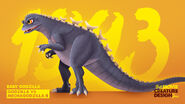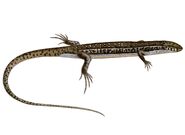| colspan=2 style="text-align: centerTemplate:; background-colorTemplate:COLON Template:Taxobox colour" | Wrasses | |
|---|---|
| Script error: No such module "InfoboxImage". | |
| Moon wrasse, Thalassoma lunare, a typical wrasse | |
| colspan=2 style="text-align: centerTemplate:; background-colorTemplate:COLON Template:Taxobox colour" | Scientific classification | |
| colspan=2 style="text-align: centerTemplate:; background-colorTemplate:COLON Template:Taxobox colour" | Genera | |
|
See text. | |
Template:Otheruses The wrasses are a family (biology), Labridae, of marine fish, many of which are brightly colored. The family is large and diverse, with about 500 species in 60 genera.
They are typically small fish, with most less than Template:Convert long, although the largest, the Humphead wrasse, can measure up to Template:Convert. They are efficient carnivores, feeding on a wide range of small invertebrates. Many smaller wrasses follow the feeding trails of larger fish, picking up invertebrates disturbed by their passing.[1]
Distribution[]
Wrasses are exclusively marine in distribution. They are found in the Atlantic, Indian, and Pacific Oceans, usually in shallow water habitats such as coral reefs and rocky shores where they live close to the substrate.
Anatomy[]
Wrasses have protractile mouths, usually with separate jaw teeth that jut outwards. The dorsal fin has 8–21 spines and 6–21 soft rays, usually running most of the length of the back. Wrasse are typically brightly coloured and sexually dimorphic. Many species are capable of changing sex: juveniles are a mix of males and females (known as Initial Phase or IP individuals) but the largest adults becoming territory-holding (Terminal Phase or TP) males.
The wrasses have become a primary study species in the biomechanics of fish-feeding due to their jaw structure. The nasal and mandibular bones are connected at their posterior ends to the rigid neurocranium, and the superior and inferior articulations of the maxilla are joined to the anterior tips of these two bones, respectively, creating a loop of 4 rigid bones connected by moving joints. This "4-bar linkage" has the interesting property of having numerous possible arrangements to achieve a given mechanical result (fast jaw protrusion or a forceful bite), thus decoupling morphological diversity from functional diversity. The actual morphology of wrasses reflects this, with many lineages displaying different jaw morphology that results in the same functional output and a similar or identical ecological niche.[2]
Cleaner wrasse[]
- Main article: Bluestreak cleaner wrasse

Dragon wrasse Novaculichthys taeniourus being cleaned by a pair of cleaner wrasses, Labroides sp. on a reef in Hawaii
Some wrasses are widely known for their role as symbiotic fish, similar to the actions and those ascribed to the Egyptian plover: other fish will congregate at wrasse cleaning stations and wait for wrasses to swim into their open mouths and gill cavities to have gnathiid parasites removed. The cleaner wrasses are best known for feeding on dead tissue and scales and ectoparasites, although they are also known to 'cheat' through the removal of healthy tissue and mucus, which is costly for the client fish to produce. The bluestreak cleaner wrasse, Labroides dimidiatus is one of the most common cleaners found on tropical reefs. Few cleaner wrasses have been observed being eaten by predators, possibly because the removal of parasites from the predator fish is more important for the survival of the predator than the short-term gain of eating the cleaner.[3]
Other species of wrasse, rather than having fixed cleaning stations, specialize in making "house calls"—that is, their "clientele" are those fish that are too territorial or shy to go to a cleaning station. Template:Clearleft
Significance to humans[]
Wrasse are utilised as food in many parts of the world. In the western Atlantic, the most commonly eaten is the tautog.Template:Dubious Wrasse are widely kept in both public and home aquaria, with some species being small enough to be considered reef safe.
Genera[]
Template:Col-breakAcantholabrusAchoerodus
Ammolabrus
Anampses
Anchichoerops
Austrolabrus
Bodianus
Centrolabrus
Cheilinus
Cheilio
Choerodon
Cirrhilabrus
Clepticus
Conniella
Coris
Ctenolabrus
Cymolutes
Decodon
Template:Col-breakDiproctacanthus
Doratonotus
Dotalabrus
Epibulus
Eupetrichthys
Frontilabrus
Gomphosus
Halichoeres
Hemigymnus
Hologymnosus
Iniistius
Julichthys
Labrichthys
Labroides
Labropsis
Labrus
Lachnolaimus
Lappanella
Template:Col-breakLarabicus
Leptojulis
Macropharyngodon
Malapterus
Minilabrus
Nelabrichthys
Notolabrus
Novaculichthys
Novaculoides
Ophthalmolepis
Oxycheilinus
Oxyjulis
Paracheilinus
Parajulis
Pictilabrus
Polylepion
Pseudocheilinops
Pseudocheilinus
Template:Col-breakPseudocoris
Pseudodax
Pseudojuloides
Pseudolabrus
Pteragogus
Semicossyphus
Stethojulis
Suezichthys
Symphodus
Tautoga
Tautogolabrus
Terelabrus
Thalassoma
Wetmorella
Xenojulis
Xiphocheilus
Xyrichtys
References[]
Template:Refimprove Template:Reflist
External links[]
Template:Commonscat
ca:Làbrid
de:Lippfische
dv:ހިކާ އާއިލާ (މަސް)
es:Labridae
fa:زمردماهیان
fr:Girelle
it:Labridae
lt:Lūpažuvinės
nl:Lipvissen
ja:ベラ
no:Leppefisker
nn:Leppefisk
pl:Wargaczowate
pt:Labridae
fi:Huulikalat
sv:Läppfiskar
zh:隆頭魚科








